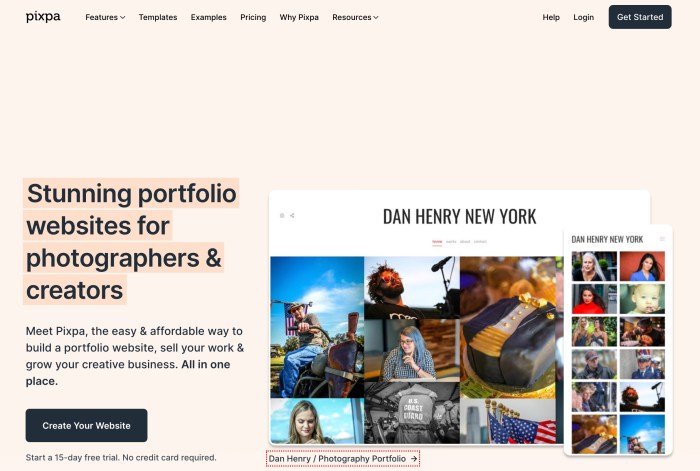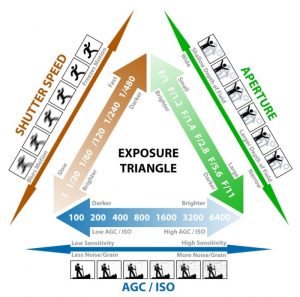
How to build an online portfolio for photographers sets the stage for this enthralling narrative, offering readers a glimpse into a story that is rich in detail with casual formal language style and brimming with originality from the outset.
This guide delves into the essential steps required to create a visually stunning and engaging online portfolio tailored specifically for photographers.
Introduction to Online Portfolios for Photographers

Having an online portfolio as a photographer is crucial in showcasing your work to potential clients in a visually appealing and professional manner. It serves as a digital gallery where you can display your best photographs, creating a lasting impression on visitors.
Importance of an Online Portfolio
An online portfolio is a powerful tool that allows photographers to present their work to a wide audience, including potential clients and collaborators. It provides a centralized platform where you can showcase your skills, style, and creativity, helping you stand out in a competitive industry.
Showcasing Work to Potential Clients
- Display a diverse range of photographs to demonstrate your versatility and expertise.
- Include high-quality images that highlight your technical skills and artistic vision.
- Organize your portfolio in a way that is easy to navigate, allowing visitors to explore your work effortlessly.
- Provide contact information or a booking form for interested clients to reach out to you easily.
Benefits of a Well-Structured Online Portfolio
- Establish credibility and professionalism in the eyes of potential clients.
- Attract new clients and opportunities by showcasing your best work effectively.
- Create a lasting impression with a visually appealing and user-friendly portfolio design.
- Stand out from competitors and differentiate your photography style through a well-curated selection of images.
Choosing the Right Platform

When it comes to building an online portfolio for photographers, selecting the right platform is crucial to effectively showcase your work and attract potential clients. There are several website builders and platforms available, each with its own set of features and capabilities. It’s essential to choose a platform that aligns with your style, needs, and the type of photography you specialize in.
Comparison of Different Platforms
- WordPress: Known for its flexibility and customization options, WordPress offers a wide range of themes and plugins specifically designed for photographers. It allows for complete control over the design and functionality of your portfolio.
- Squarespace: Squarespace is a user-friendly platform with beautifully designed templates that are perfect for showcasing visual content. It’s a great option for photographers who want a polished and professional-looking portfolio without the need for extensive technical knowledge.
- Wix: Wix is another popular website builder that offers a drag-and-drop interface, making it easy to create a visually appealing portfolio. It also provides a variety of templates and design options suitable for photographers.
Choosing the Right Platform
- Consider the design options: Look for platforms that offer templates and customization features that complement your photography style. Ensure the platform allows you to showcase your work in a visually appealing way.
- Mobile responsiveness: In today’s mobile-driven world, it’s essential to choose a platform that ensures your portfolio looks great on all devices, including smartphones and tablets.
- Ease of use: Opt for a platform that is user-friendly and intuitive, especially if you’re not tech-savvy. This will make it easier for you to update and maintain your portfolio regularly.
- capabilities: Choose a platform that provides good tools to help your portfolio rank higher in search engine results, making it easier for potential clients to find you online.
Designing an Engaging Portfolio
Creating a visually appealing online portfolio is crucial for photographers to showcase their work effectively. The design of your portfolio can make a significant impact on how viewers perceive your work and can help you stand out in a competitive field.
Organizing Images and Galleries
When organizing images in your portfolio, consider creating galleries based on themes, projects, or styles. This helps viewers navigate through your work easily and allows them to see the range and depth of your photography skills. Make sure to include a variety of images to showcase your versatility.
- Arrange images in a logical order, starting with your strongest pieces.
- Include a mix of close-up shots, landscapes, portraits, and other types of photography to showcase your skills.
- Consider adding captions or descriptions to provide context for each image.
Responsive Design for Mobile and Desktop Users
In today’s digital age, it’s essential to ensure that your online portfolio is responsive and optimized for both mobile and desktop users. With the increasing use of smartphones and tablets, many viewers will access your portfolio on their mobile devices.
- Choose a platform that offers responsive design templates or customize your portfolio to be mobile-friendly.
- Test your portfolio on different devices to ensure that images load quickly and the layout is easy to navigate on all screen sizes.
- Optimize images for web to reduce loading times on mobile devices without compromising quality.
Showcasing Photography Work
When it comes to showcasing photography work in your online portfolio, selecting the best images and presenting them effectively is crucial. Your portfolio should not only display your skills and style but also engage viewers and leave a lasting impression.
Selecting the Best Images
- Choose high-quality images that showcase your technical skills and creativity. Images should be sharp, well-composed, and properly exposed.
- Select images that demonstrate a range of styles and subjects to showcase your versatility as a photographer.
- Avoid including similar or redundant images to maintain viewer interest and showcase variety in your work.
Importance of Image Quality, Consistency, and Storytelling
- Image quality is essential as it reflects your professionalism and attention to detail. Make sure your images are sharp, properly processed, and free of distractions.
- Consistency in style and editing helps create a cohesive portfolio that reflects your unique vision as a photographer.
- Storytelling through your images can create a connection with viewers and evoke emotions. Choose images that tell a story or evoke a feeling to engage your audience.
Categorizing and Labeling Photography Projects
- Organize your photography projects into categories or series to make it easier for viewers to navigate your portfolio and understand your body of work.
- Label each project clearly with a title that reflects the theme or subject matter. Use brief descriptions to provide context and insights into your creative process.
- Consider creating separate galleries or sections for different types of photography, such as portraits, landscapes, or events, to showcase your expertise in each area.
Writing Compelling Descriptions
When it comes to building an online portfolio for photographers, writing compelling descriptions for your photography projects is essential. These descriptions serve as a way to provide context, tell a story, and engage viewers with your work on a deeper level.
Role of Storytelling and Context
Using storytelling and context in your descriptions can help create a connection with viewers and make your photography projects more memorable. By sharing the inspiration behind each project, the process of creating the images, or the emotions captured in the photos, you can give viewers a glimpse into your creative vision and personal perspective.
- Describe the story behind the photo shoot, including any challenges or interesting moments that occurred during the process.
- Share the emotions or message you aimed to convey through the images, giving viewers a deeper understanding of the intention behind your work.
- Provide context about the location, subjects, or theme of the project to help viewers connect with the images on a more personal level.
Examples of Effective Descriptions
Example 1: “This series of black and white portraits captures the raw emotions of individuals in vulnerable moments, emphasizing the beauty and strength found in vulnerability.”
Example 2: “Inspired by the vibrant colors of nature, these landscape photographs aim to evoke a sense of peace and tranquility, inviting viewers to escape into the beauty of the natural world.”
Example 3: “Through a combination of light and shadow, these abstract images explore the concept of duality and challenge viewers to see beyond the surface of everyday objects.”
Adding Contact and Call-To-Action Elements
When creating an online portfolio as a photographer, it is crucial to include contact information and clear call-to-action elements. These elements play a significant role in making it easy for potential clients to reach out or hire you for their photography needs.
Including Contact Information
One of the first things you should do is provide multiple ways for clients to contact you. This can include your email address, phone number, social media links, and a contact form directly on your portfolio website.
- Ensure that your contact information is easily accessible from any page on your portfolio.
- Consider using a separate “Contact” page with detailed instructions on how clients can reach out to you.
- Regularly check and respond to inquiries promptly to show your professionalism and dedication to potential clients.
Implementing Call-To-Action Buttons
Call-to-action buttons are essential for guiding visitors towards taking the next step, whether it’s booking a session, requesting a quote, or viewing more of your work.
- Place clear and visually appealing CTA buttons strategically throughout your portfolio.
- Use action-oriented phrases like “Book Now,” “Get in Touch,” or “View Portfolio” to prompt visitors to take action.
- Make sure the CTA buttons stand out from the rest of the content on the page to attract attention.
Examples of Effective Contact and CTA Elements
Here are some examples of how photographers have successfully incorporated contact and CTA elements into their portfolios:
On the homepage, a prominent “Contact Me” button that leads to a simple contact form for inquiries.
At the end of each portfolio gallery, a “Book a Session” button that directs visitors to a scheduling page with available dates and pricing information.
Within the about me section, a CTA button saying “Learn More About My Services” that links to a page detailing the photographer’s offerings.
In conclusion, mastering the art of building an online portfolio for photographers is a crucial step towards showcasing your work effectively and attracting potential clients in the competitive photography industry.
Questions Often Asked
What is the importance of having an online portfolio as a photographer?
Having an online portfolio allows photographers to showcase their work to a wider audience, attract potential clients, and establish a professional online presence.
How to choose the right platform for creating an online portfolio?
Consider factors like ease of use, design flexibility, and integration options when selecting a platform that aligns with your style and needs as a photographer.
Why is responsive design important for an online portfolio?
Responsive design ensures that your portfolio looks great and functions well on all devices, providing a seamless user experience for both mobile and desktop users.






